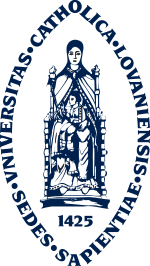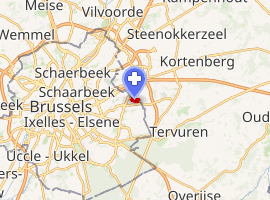Cliniques universitaires Saint-Luc
The Cliniques universitaires Saint-Luc (UCLouvain Saint-Luc) is a non-profit-making (ASBL) hospital of the University of Louvain (UCLouvain),[1] located on the university campus of UCLouvain Bruxelles Woluwe in Woluwe-Saint-Lambert, Brussels, Belgium. The hospital opened on 23 August 1976.
| Saint-Luc University Hospital | |
|---|---|
| University of Louvain | |
 | |
 Sedes Sapientiae, seal of UCLouvain | |

| |
| Geography | |
| Location | UCLouvain Brussels Woluwe, Woluwe-Saint-Lambert, Brussels, Belgium |
| Organisation | |
| Care system | Private ASBL |
| Funding | Government hospital |
| Type | Teaching |
| Affiliated university | UCLouvain |
| Services | |
| Emergency department | Yes |
| Beds | 973 |
| Helipad | ICAO: EBUC |
| History | |
| Opened | 1976 |
| Links | |
| Website | http://www.saintluc.be/ |
| Lists | Hospitals in Belgium |
| Other links | List of hospitals in Belgium |
History
In 1968 the Catholic University of Louvain acquired some land in the east of Brussels, which did not have a large hospital at that time. When the university split into two the French-speaking part moved to Ottignies except for the medical faculty and health sciences sector, which moved to the Brussels site.
It is one of the two main university hospitals of the Université catholique de Louvain, the other being the CHU UCLouvain Namur, in the Walloon province of Namur.
Research
Being a teaching and university hospital UCLouvain Saint-Luc continues to do ground breaking medical research. For example, the first baby born after ovarian transplant[2] and the first photograph of human ovulation.[3]
Famous people born at Cliniques universitaires Saint-Luc
- Prince Amedeo, Princess Maria Laura and Prince Joachim, born in 1986, 1988 and 1991 respectively.
- Princess Louise of Belgium, twins Prince Nicolas of Belgium and Prince Aymeric of Belgium, born in 2004 and 2005, respectively.
References
- "Statutes of the Cliniques universitaires Saint-Louis". just.fgov.be. 11 September 2018.
- New Scientist First baby born after ovarian transplant 24 September 2004.
- New Scientist Human egg makes accidental debut on camera